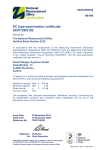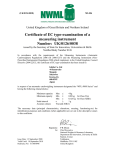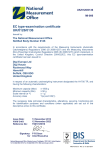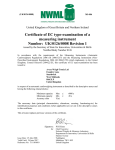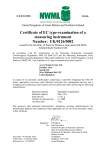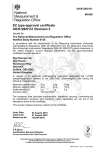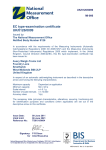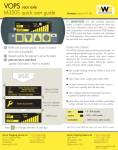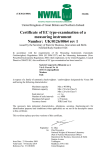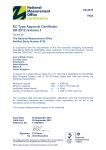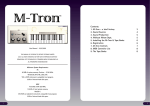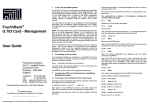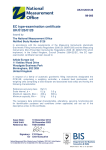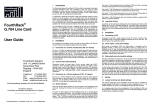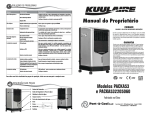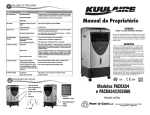Download EC type-examination certificate UK/0126/0098
Transcript
UK/0126/0098 MI-006 EC type-examination certificate UK/0126/0098 Issued by: The National Measurement Office Notified Body Number 0126 In accordance with the requirements of the Measuring Instruments (Automatic Catchweighers) Regulations 2006 (SI 2006/1257) and the Measuring Instruments (Non-Prescribed Instruments) Regulations 2006 (SO 2006/1270) which implement, in the United Kingdom, Council Directive 2004/22/EC, this EC type-examination certificate has been issued to: Vehicle Weighing Solutions Limited Southview Park Caversham Reading Berkshire RG4 5AF United Kingdom in respect of a vehicle-mounted automatic catchweighing instrument designated the Enviroweigh and having the following characteristics: Maximum capacity Minimum capacity Scale interval Accuracy class Max Min e Y(b) ≤ ≥ ≥ 300 kg 5 kg 1 kg The necessary data (principal characteristics, alterations, securing, functioning etc) for identification purposes and conditions (when applicable) are set out in the descriptive annex to this certificate. Issue Date: Valid Until: Reference No: 19 March 2012 18 March 2022 TS0101/0002 Signatory: P R Dixon for Chief Executive National Measurement Office | Stanton Avenue | Teddington | TW11 0JZ | United Kingdom Tel +44 (0)20 8943 7272 | Fax +44 (0)20 8943 7270 | Web www.bis.gov.uk/nmo 0135 MID Annex B Rev. 2 01 April 2011 Descriptive Annex 1 INTRODUCTION The instrument, designated the Enviroweigh®, is a battery-operated automatic catchweighing instrument consisting of load cells, electronic equipment and position sensors mounted at the rear of a bin collection vehicle. The instrument automatically determines the weight of the loaded bin during the lifting process, then the weight of the empty bin on the way down to determine the net weight of refuse emptied. The instrument is designed to weigh statically or dynamically. In addition, the bin may be identified by an RFID tag reader system. The data is displayed on an indicator mounted near the operating console. Each lifting “chair” at the back of the vehicle is fitted with one load cell, the outputs are used by the instrument (using dual channel configuration) to determine the weight of individual bins (2 wheeled bins, left and right hand sides) or large bins (4 wheeled bins), the weights for each channel being added to obtain the total weight. 2 FUNCTIONAL DESCRIPTION 2.1 Mechanical Figure 1 shows a typical installation, with Figure 2 showing the block diagram for the instrument. 2.1.1 Load cell The instrument comprises one (small bin) or two (large bin) load cells type DT4650, maximum capacity 1000kg, mounted on the lifter at the rear of the vehicle (Figure 3). 2.1.2 Inclinometer The instrument comprises an inclinometer type ADXL325 or ADXL327, manufactured by Analogue Devices and mounted near the lifter. The sensor acts as a switch and prevents weighing above the maximum tilt angle. The maximum tilt angle shall be determined at initial verification and protected as part of the legally relevant parameters, and shall not exceed 8%. 2.1.3 Position sensor A position sensor type IFS209, manufactured by Pepperl & Fuchs, is mounted on the lifter. Its output is used to determine the weighing window within which the dynamic weight is calculated. 2.2 Electrical 2.2.1 The pattern operates from 9-32 V DC, supplied from the 12 or 24 V DC vehicle battery. The indicator console is fitted with a non-volatile static RAM with Lithium battery to maintain the basic functions such as clock, etc 2.2.2 PCB/CPU/ADC The load cell output is digitized by the AD converter type CS5532 24 bit manufactured by Cirrus Logic. 2/11 2.2.3 Weighing module The weigh module is housed in a die cast IP66 sealed enclosure. Calibration setting, transaction record and configuration settings are stored on a solid state flash memory. Communication is via CAN messaging. Figure 9 shows the weighing module. 2.2.4 I/O Control module The I/O control module is housed in a die cast IP66 sealed enclosure. Digital input / output signals from the vehicle are processed and communication is via CAN messaging. Figure 4 shows the I/O control module. 2.2.5 Indicator The 350 weight indicator displays weight data, current lifter status, total weights, RFID tag numbers and fault diagnosis. Communication is via CAN messaging. Figure 5 shows the indicator. 2.2.6 RFID Control module / Tag readers The RFID control module is housed in a die cast IP66 sealed enclosure. The unit can power up to 2 separate RFID antennas. RFID tag information is decoded and transmitted via CAN messaging. Figure 6 shows the RFID antenna and Figure 7 shows the RFID control module. 2.3 Devices and interlocks 2.3.1 The instrument is provided with a semi-automatic zero setting, the range of zero is +/- 2% Max. 2.3.2 The calculation of net weights are determined by the difference between the rising “full” bin and falling “empty” bin hence any errors due to a drift of zero cannot affect the net result, provided the drift remains in an acceptable range. This is achieved by checking the real time mV output of the load cell while a bin is not on the lifter. If the drift remains outside the pre-set limit of +/- 2% Max from the zero point over consecutive samples for 5 seconds, a flag will be set and weighing shall be prevented. If the output drifts back into range the flag will be cleared and weighing resumed. 2.3.3 Data storage The measurement data is automatically stored in an internal SD card located in the sealed weighing module, and can be retrieved via the communication ports. The following data is recorded: − − − − − − − Weigh module serial number Incremental transaction number Data of transaction Time of transaction NET weight of transaction and unit of measurement RFID tag number (if used) Lifter used (left, right or trade – with trade used to designate large bins) 2.3.4 The indicator runs through a standard check at power up, defects shall be obvious to the user, and displayed as error messages. 3/11 2.3.5 The following interlocks prevent the weighing process: Real time clock not running Storage card not responding Load cell output error − − − 2.4 Operation A bin is placed on the lifter The lifter raises the bin The RFID tag is read when present Lifter reached weighing position ‘UP’ weight is calculated Bin contents is emptied into the vehicle Lifter then lowers to weighing position ‘DOWN’ weight is calculated Resultant NET weight is calculated, displayed and recorded Bin is removed Sequence complete − − − − − − − − − − − 3 TECHNICAL DATA 3.1 The system has the following technical characteristics: Small bin Large bin ≤ 100 kg ≤ 300 kg Scale interval (e =): ≥ 1 kg ≥ 2 kg Minimum capacity (Min): ≥ 5 kg ≥ 10 kg Maximum capacity (Max): Operation Static/Dynamic -20°C to +50 °C Climatic environment 350 indicator: Non-condensing (closed) 350 indicator in IP66 enclosure and other parts: Condensing (open) Electromagnetic environment E3 Power supply 9-32 VDC (via 12 or 24 V vehicle battery) Accuracy class Y(b) Cable length (load cell to indicator): 5m 3.2 Documentation and drawings Enviroweigh® manual ver 2.8 GA 04298 issue 2 GA 04247 issue 4 RFID_issue_4.0 WEIGH_issue_7.0 INTERFACE_issue_5.0 rfid4.sch weigh7.sch io5.sch User manual Enviroweigh® mounting arrangement Enviroweigh® Schematic RFID board PCB layout Weigh board PCB Layout Control I/O board PCB layout RFID board Circuit diagram WEIGH board Circuit diagram Control I/O board Circuit diagram 4/11 3.3 Software 3.3.1 Verification information On power up, the LED pixels on the 350 display are inverted to confirm operation. The display shows the software firmware version. The weighing module version (3.00), last calibration date and incremental calibration number are then displayed on the screen before the system reverts to normal weighing mode. 3.3.2 Security The source code is compiled and downloaded into the micro controller. The device is then protected to prevent removal or modification of the software code. Calibration is accessed via a password protected parameter. When a calibration is carried out, the date and incremental calibration number is recorded to solid state flash memory. The solid state flash memory is sealed within the weighing module. On power up, the date and sequential calibration number is displayed on the screen prior to system operation. 4 PERIPHERAL DEVICES AND INTERFACES 4.1 Interfaces The instrument may have the following interfaces: − − − 4.2 6-wire load cell connection RS232 CAN bus communication. Peripheral devices The instrument may be connected to any peripheral device that has been issued with a test certificate or parts certificate by a Notified Body responsible for Annex B (MI-006) under Directive 2004/22/EC in any Member State and bears the CE marking of conformity to the relevant directives; or A peripheral device without a test certificate may be connected under the following conditions: − it bears the CE marking for conformity to the EMC Directive; − it is not capable of transmitting any data or instruction into the weighing instrument, other than to release a printout, checking for correct data transmission or validation; − it prints weighing results and other data as received from the weighing instrument without any modification or further processing; and − it complies with the applicable requirements of Paragraph 8.1 of Annex I. 5/11 5 APPROVAL CONDITIONS The certificate is issued subject to the following conditions: 5.1 Legends and inscriptions 5.1.1 The following legends are durably and legibly marked on a label (Figure 8) fixed on the control enclosure so that it is visible to the user (Figure 9): ‘CE’ marking Supplementary metrology marking Notified Body verification mark Accuracy class Serial number Manufacturers mark or name Certificate number Max Min e= 5.1.2 All components are identified by individual serial numbers. 6 LOCATION OF SEALS AND VERIFICATION MARKS 6.1 The CE mark shall be impossible to remove without damaging it. The labels shall be impossible to remove without them being destroyed. The markings and inscriptions shall fulfil the requirements of Paragraph 9 of Annex I of the Directive 2004/22/EC. 6.2 Access to the configuration and calibration facility is via the password protection on the 350 display. 6.3 Every time the configuration or calibration is modified, the calibration number counter is incremented (see 3.3.2) and shall to be recorded on the instrument on a descriptive label near the rating plate. The label shall be impossible to remove without being destroyed. 6.4 Components that may not be dismantled or adjusted by the user will be secured by common serial numbers, a wire and seal or tamper evident label and securing mark. The securing mark may be either: 7 − a mark of the manufacturer and/or manufacturer’s representative, or − an official mark of a verification officer. ALTERNATIVES There are at present no alternatives. 6/11 8 ILLUSTRATIONS Figure 1 Figure 2 Figure 3 Figure 4 Figure 5 Figure 6 Figure 7 Figure 8 Figure 9 Typical installation Block Diagram Load cell mounted on the lifter Control and I/O boards in enclosure Indicator near operating console RFID antenna at rear of vehicle RFID control box at rear of vehicle Rating plate Labelled weigh control enclosure 9 CERTIFICATE HISTORY ISSUE NO. DATE DESCRIPTION UK/0126/0098 19 March 2012 Type examination certificate first issued. 7/11 R R ENVIROWEIGH RR WEIGHING WEIGHING MODULE MODULE www.vwsltd.co.uk R R R R ENVIROWEIGH RR ENVIROWEIGH RR I/O I/O CONTROL CONTROL MODULE MODULE RFID RFID CONTROL CONTROL MODULE MODULE www.vwsltd.co.uk Figure 1 Figure 2 Typical installation Block diagram 8 www.vwsltd.co.uk Figure 3 Figure 4 Figure 5 Load cell mounted on lifter Control and I/O boards in enclosure Indicator near operating console 9 Figure 6 Figure 7 RFID antenna at rear of vehicle RFID control box at rear of vehicle Figure 8 Rating plate 10 Figure 9 Labelled weigh control enclosure © Crown Copyright 2012 NATIONAL MEASUREMENT OFFICE Department for Business, Innovation & Skills 11












